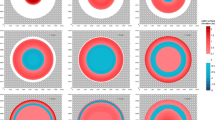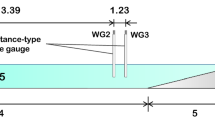Abstract
One of the most important aspects in tsunami studies is the behaviour of the wave when it approaches the coast. Information on physical parameters that characterize waves is often limited because of the difficulties in achieving accurate measurements at the time of the event. The impact of a tsunami on the coast is governed by nonlinear physics, such as turbulence with spatial and temporal variability. The use of the smoothed particle hydrodynamic method (SPH) presents advantages over models based on two-dimensional shallow waters equations, because the assumed vertical velocity simplifies the hydrodynamics in two dimensions. The study presented here reports numerical SPH simulations of the tsunami event which occurred in Coquimbo (Chile) in September, 2015. On the basis of the reconstruction of the physical parameters that characterized this event (flow velocities, direction and water elevations), calibrated by a reference model, the force values on buildings in the study area were numerically calculated and compared with an estimate given by the Chilean Structural Design Standard. Discussion and conclusions of the comparison of both methodologies are presented, including an analysis of the influence of the topographic details of the model in the estimation of hydrodynamic forces.
















Similar content being viewed by others
References
Altomare C, Crespo AJC, Rogers BD, Dominguez JM, Gironella X, Gómez-Gesteira M (2014) Numerical modelling of armour block sea breakwater with smoothed particle hydrodynamics. Comput Struct 130:34–45. https://doi.org/10.1016/j.compstruc.2013.10.011
Altomare C, Crespo AJC, Dominguez JM et al (2015) Applicability of smoothed particle hydrodynamics for estimation of sea wave impact on coastal structures. Coast Eng 96:1–12. https://doi.org/10.1016/j.coastaleng.2014.11.001
Aránguiz R, González G, González J et al (2016) The 16 September 2015 Chile tsunami from the post-tsunami survey and numérical modeling perspectives. Pure Appl Geophys 173(2):333–348
Aránguiz R, Urra L, Okuwaki R, Yagi Y (2017) Development and application of tsunami fragility curve of the 2015 tsunami in Coquimbo, Chile. Nat Hazards Earth Syst Sci. https://doi.org/10.5194/nhess-2017-364
Aristodemo A, Tripepi G, Meringolo DD, Veltri P (2017) Solitary wave-induced forces on horizontal circular cylinders: laboratory experiments and SPH simulations. Coast Eng 129:17–35. https://doi.org/10.1016/j.coastaleng.2017.08.011
ASCE (2016) Minimum design loads for buildings and other structures, ASCE/SEI Standard 7-05. American Society of Civil Engineers, Reston, Virginia
Carvajal M, Cisternas M, Gubler A, Catalán PA, Winckler P, Wesson RL (2016) Reexamination of the magnitudes for the 1906 and 1922 Chilean earthquakes using Japanese tsunami amplitudes: implications for source depth constraints. J Geophys Res Solid Earth 122:4–17. https://doi.org/10.1002/2016JB013269
Crespo AJC, Gómez-Gesteira M, Dalrymple RA (2007) 3D SPH simulation of large waves mitigation with a dike. J Hydraul Res 45(5):631–642
Crespo AJC, Domínguez JM, Rogers BD, Gómez-Gesteira M, Longshaw S, Canelas R et al (2015) DualSPHysics: open-source parallel CFD solver based on smoothed particle hydrodynamics (SPH). Comput Phys Commun 187:204–216
De Leffe M, Le Touzé D, Alessandrini B (2010) SPH modeling of shallow-water coastal flows. J Hydraul Res 48(S1):118–125
Gingold RA, Monaghan JJ (1977) Smoothed particle hydrodynamics: theory and application to non-spherical stars. Mon Not R Astron Soc 181(3):375–389
Gómez-Gesteira M, Dalrymple RA (2004) Using a three-dimensional smoothed particle hydrodynamics method for wave impact on a tall structure. J Waterw Port Coast Ocean Eng 130(2):63–69
Gómez-Gesteira M, Cerqueiro D, Crespo C, Dalrymple RA (2005) Green water overtopping analyzed with a SPH model. Ocean Eng 32(2):223–238
González-Cao J, García-Feal O, Domínguez JM, Crespo AJC, Gómez-Gesteira M (2018) Analysis of the hydrological safety of dams combining two numerical tools: Iber and DualSPHysics. J Hydrodyn 30(1):87–94
González-Cao J, Altomare C, Crespo AJC, Domínguez JM, Gómez-Gesteira M, Kisacik D (2019) On the accuracy of DualSPHysics to assess violent collisions with coastal structures. Comput Fluids 179:604–612. https://doi.org/10.1016/j.compfluid.2018.11.021
Gotoh H, Khayyner A (2018) On the state-of-the-art of particle methods for coastal and ocean engineering. Coast Eng J 69:79–103. https://doi.org/10.1080/21664250.2018.1436243
Heintz JA, Mahoney M (2008) Guidelines for design of structures for vertical evacuation from tsunamis. FEMA P646/June 2008
Monaghan JJ (1992) Smoothed particle hydrodynamics. Ann Rev Astron Astrophys 30(1):543–574
Monaghan JJ, Lattanzio JC (1987) A refined method for astrophysical problems. Astron Astrophys 149(1):135–143
ONEMI (2015) Oficina Nacional de Emergencia del Ministerio del Interior y Seguridad Pública. Monitoreo por sismo de mayor intensidad. Publishing ONEMI Web. http://www.onemi.cl/alerta/se-declara- alerta-roja-por-sismo-de-mayor-intensidad-y-alarma-de-tsunami/
SHOA (2000) Servicio Hidrográfico y Oceanográfico de la Armada de Chile. Cómo sobrevivir a un maremoto. Valparaíso, Chile. Primera edición, p 15
SHOA (2015) Carta de Inundación por tsunami, La Serena-Coquimbo. Servicio Hidrográfico y Oceanográfico de la Armada de Chile. http://www.shoa.cl/servicios/citsu/pdf/CITSU_ Coquimbo_La_Serena_2da_Ed._2015.pdf
Soloviev SL, Go CN (1984) Catalogue of tsunamis on the eastern shore of the Pacific Ocean. Department of Fisheries and Oceans, Institute of Ocean Sciences, Sidney
St-Germain P, Nistor I, Townsend R, Shibayama T (2013) Catalogue of tsunamis on the eastern shore of the Pacific Ocean. Department of Fisheries and Oceans, Institute of Ocean Sciences, Sidney
Taylor KE (2001) Summarizing multiple aspects of model performance in a single diagram. J Geophys Res Atmos 106 (D7):7183–7192
Wei Z, Dalrymple RA (2016) Numerical study on mitigating tsunami force on bridges by an SPH model. J Ocean Eng Mar Energy 2(3):365–380
Wei Z, Dalrymple RA, Hérault A, Bilotta G, Rustico E, Yeh H (2015) SPH modeling of dynamic impact of tsunami bore on bridge piers. Coast Eng 104:26–42
Yamazaki Y, Kowalik Z, Cheung KF (2009) Depth-integrated, non-hydrostatic model for wave breaking and run-up. Int J Numer Methods Fluids 61(5):473–497
Yamazaki Y, Cheung KF, Kowalik Z (2011) Depth-integrated, non-hydrostatic model with grid nesting for tsunami generation, propagation, and run-up. Int J Numer Methods Fluids 67(12):2081–2107
Acknowledgements
We are grateful for funding from the Ibero-American Programme for the Development of Science and Technology (CYTED) under Project 516RT0512, CONICYT (Chile) the Grant FONDAP 15110017, the European Union Horizon 2020 programme under the ENERXICO Project, Grant Agreement No. 828947 and the Mexican CONACYT- SENER-Hidrocarburos Grant Agreement No. B-S-69926. The numerical calculations for this paper were performed on the ABACUS-I supercomputer of the Centro de Matematica Aplicada y Computo de Alto Rendimiento, CINVESTAV-ABACUS. We would also like to thank the EPHYSLAB group of the University of Vigo (Spain) for their support.
Author information
Authors and Affiliations
Corresponding author
Additional information
Publisher's Note
Springer Nature remains neutral with regard to jurisdictional claims in published maps and institutional affiliations.
Rights and permissions
About this article
Cite this article
Klapp, J., Areu-Rangel, O.S., Cruchaga, M. et al. Tsunami hydrodynamic force on a building using a SPH real-scale numerical simulation. Nat Hazards 100, 89–109 (2020). https://doi.org/10.1007/s11069-019-03800-3
Received:
Accepted:
Published:
Issue Date:
DOI: https://doi.org/10.1007/s11069-019-03800-3




